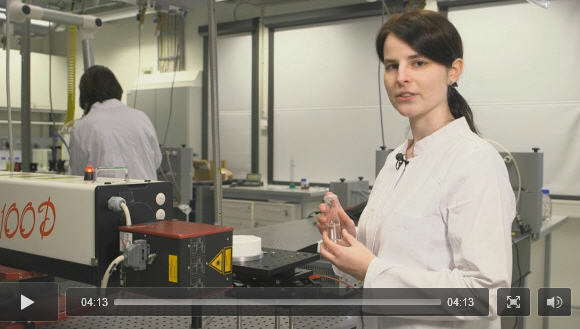Movie Shows Development of a Wound Dressing Research in Fast Motion

A short movie made by the group of Prof. Dr.-Ing. Stephan Barcikowski (University of Duisburg-Essen) shows the development of a dressing that promotes wound healing – from the materials research laboratory until the first practical trial (in English).
Even small area burns can be delicate, because healthy skin is our largest and most effective barrier against pathogens. It is therefore essential to support the wound healing process and to fight germs at the same time. Some metal ions, such as zinc or iron are known to accelerate healing.
Currently, the challenge for research is to develop an appropriate substrate to release the active ingredients gradually. In addition, it must be ensured that the active ingredients are harmful to bacteria but harmless to the human body.
Technical Chemist Nina Million from University of Duisburg-Essen (UDE) has developed a wound dressing containing nano zinc during her master thesis and was awarded the prize for the best thesis in 2013 by the German Society for Biomaterials. She removed zinc oxide and iron oxide nanoparticles from solid targets by laser pulses and applied them in a sponge-like carrier material.
This so-called microgel is arranged like a network enclosing the particles. Applied to a wound, it gradually releases antibacterial ions, while the particles themselves remain inside the microgel. Recently, studies adjusting the dose and thus optimizing the composition were successfully completed on rats.
The development succeeded in collaboration with the DWI – Leibniz Institute for Interactive Materials in Aachen and Hannover Medical School. An approximately four-minute movie produced together with the “Beilstein Institute zur Förderung der Chemischen Wissenschaften“ in Frankfurt clearly reconstructs the development process – in terms of interviews, laboratory demonstrations and explanatory drawings.
“It was fun to make this film,” says Million. “But I also realized how difficult it is to summarize and communicate our own research in just a few words.”
She can be proud of the result „Laser rapid prototyping of bioactive materials for medical treatment“ (in English):
https://www.uni-due.de/cenide/presse_videos.php
or
http://www.beilstein.tv/tvpost/laser-rapid-prototyping-of-bioactive-materials-fo…
Responsible for Press Release: Birte Vierjahn, Tel. +49 (0) 203 379 8176, birte.vierjahn@uni-due.de
Media Contact
All latest news from the category: Life Sciences and Chemistry
Articles and reports from the Life Sciences and chemistry area deal with applied and basic research into modern biology, chemistry and human medicine.
Valuable information can be found on a range of life sciences fields including bacteriology, biochemistry, bionics, bioinformatics, biophysics, biotechnology, genetics, geobotany, human biology, marine biology, microbiology, molecular biology, cellular biology, zoology, bioinorganic chemistry, microchemistry and environmental chemistry.
Newest articles

Silicon Carbide Innovation Alliance to drive industrial-scale semiconductor work
Known for its ability to withstand extreme environments and high voltages, silicon carbide (SiC) is a semiconducting material made up of silicon and carbon atoms arranged into crystals that is…

New SPECT/CT technique shows impressive biomarker identification
…offers increased access for prostate cancer patients. A novel SPECT/CT acquisition method can accurately detect radiopharmaceutical biodistribution in a convenient manner for prostate cancer patients, opening the door for more…

How 3D printers can give robots a soft touch
Soft skin coverings and touch sensors have emerged as a promising feature for robots that are both safer and more intuitive for human interaction, but they are expensive and difficult…





















